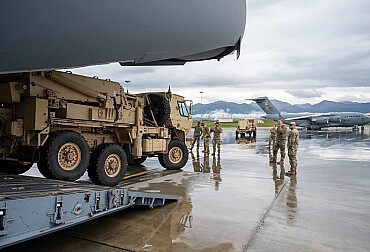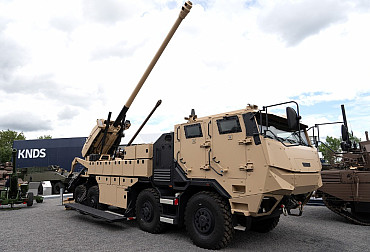The BM Oplot – the best and rare Ukrainian Main Battle Tank
The BM Oplot is the best home made Main Battle Tank of the Ukrainian Army. It is a relatively modern vehicle, yet based on an older Soviet platform. In essence it is an upgraded version of the T-84 tank, which is itself an upgraded version of the T-80UD Beryoza, basically a Soviet T-80U with a Ukrainian 6TD series diesel engine.
The whole story of the BM Oplot begins with the T-80U. The most significant component of this vehicle is its turbine engine, which makes the T-80 a very specific tank within the Russian arsenal. It had a fervent supporter in the person of Marshal Dmitry Ustinov, Soviet Defence Minister until his death in 1984. Yet not everyone was as enthusiastic as Ustinov about the idea of building a large number of turbine-powered tanks, since a turbine engine has many advantages, but also significant disadvantages, including what was the bane of the military industry at the end of the Soviet era: it was very, very expensive. At late 1980s prices, a V-46 engine of a T-72 cost around 9,600 roubles, while that of a turbine-powered GTD-1000 was 104,000 roubles – more than ten times as much. It was also a greedy engine, expensive to operate and repair and requiring a lot of maintenance. In short, it was not what the Soviet military industry as a whole expected.
That's why, very early on, experiments were carried out on adapting a diesel engine to a T-80 tank, in particular at the Kharkiv factory, which was already using compact, high-performance diesel engines in its parallel T-64 production. A new version of this diesel, called the 6TD-1 and developing 1000 hp, was used. Originally, this engine was to be used in a much-improved T-64 prototype, also equipped with a new turret (a tank called Object 476). However, if the programme failed, it would find its way into the chassis of a T-80 in another experimental programme, called Object 478.
The first Object 478 prototype was basically a T-80 chassis combined with an Object 476 turret with the 125mm 2A46M-1 smoothbore gun, and the 6TD-1 engine. An improved version called the Object 478M was also envisaged. The designers added all sorts of sophisticated and expensive components to the basic construction, including a new Sistema FCS, a Shatyor APS (which never really came to fruition) and a new 1500hp diesel engine called the 12ChN. But, as often happened, in trying to push their ideas through, they came up against two major problems: money and Ustinov, who was determined that Kharkiv should produce the T-80U, in his aim to run as many turbine-engined tanks as possible. The Object 478 programme was cancelled – at least for a while. Only about four dozen T-80Us were built. Ustinov’s death changed the projects again,
Shortly after minister’s death in 1984 an official Soviet study was published, with a clear conclusion: over the next five years, the Soviets could choose between building 2,500 diesel tanks or 1,500 turbine-powered tanks. These calculations were heavily weighted in Kharkiv's favour. As a result, the Object 478 programme was relaunched in the form of a T-80U tank that Kharkiv was building, but powered by the 1000 hp 6TD engine variant. The prototype of this tank was called Object 478B "Beryoza" (Birch). Five prototypes were built in 1985 and passed their tests. They were shown to Mr Gorbachev and, in 1986, production was approved under the name T-80UD.
Kharkiv originally wanted the tank to be called the T-84, following in the tradition of excellent Soviet models – the T-34, T-44, T-54 and T-64. Opponents argued that this was not such a good idea, as it would indicate that the Soviets were in fact using four different 'standard' MBTs at the same time (T-64, T-72, T-80 and T-84, not to mention the discontinued tanks still in service). Eventually, the dispute reached the ranks of the Supreme Soviet of the Soviet Union, where it was finally decided to retain the designation T-80UD.
In terms of combat value the T-80UD was fairly similar to the T-80 and was produced from 1986–1987 to 1991. Around 500 tanks were built up to the fall of the Soviet Union, and 300–350 of them were located in or near Kharkiv at the time of dissolution of USSR. The T-80UD model was really known to the public. It first appeared openly at the 1990 Victory Day military parade, and only came to prominence when a T-80UD serving with the 4th Kantemirovskaya Guard Brigade attacked the White House in Moscow during the 1993 Constitutional Crisis. As a service vehicle, it was withdrawn from Russian service in 1995.
With the dissolution of the Soviet Union in 1991, demand and military funding collapsed and the Malyshev plant in Kharkiv was left to fend for itself. The main problem was the sudden shortage of components produced outside Ukraine. Over 70% of all T-80UD components were produced in Russia and had to be bought in cash, which the factory in particular and Ukraine in general did not have. Kharkiv was left with only one option: to build for export. And to do this, they modernised the T-80UD to make it more attractive.
They had to replace the components that were no longer available. The turret was a particular problem, as the original manufacturer, Azovstal of Mariupol, had gone bankrupt. To replace it, the Kharkiv factory designed a new welded turret. The protection levels of this turret are not known, but some experts estimate that they are roughly equal to those of the T-80U's standard moulded turret. Thus improved, the T-80UD (or Object 478B) became Object 478BK (with a K for katannaya, meaning welded). This tank, along with several other Kharkiv prototypes were successfully tested in Pakistan and a large order of 320 units was placed by the Pakistani Army in 1996. The tanks were delivered between 1997 and 1999. Of these 320 tanks, 145 had a standard moulded turret (52 built during the Soviet era) and this export variant was called the Object 478BE. The others had the new BK turret and this version was called Object 478BE-1. Some of these machines apparently came directly from Ukrainian Army stocks – the number of T-80UDs in service was reduced from 350 to 271.
The T-80UD continued to evolve. The experimental Object 478D series of tanks was used to test a whole new range of components, including a Ukrainian copy of the 2A46M-1 125mm smoothbore gun, known as the KBA-3; Aynet FCS, enabling the tank to fire HE shells with a programmable detonation point; TPN-4 Buran-E night sight; a 1500 hp version of the 6TD engine, called the 6TD-3 (rejected due to additional development costs); a Ukrainian copy of the APS Soft Kill Shtora; and different suspensions. The best of these were shown at the IDEX exhibition in Abu Dhabi in 1995 under a new name T-84.
Unlike Kharkiv's improved T-80UD, the T-84 did not attract many people, not even the Ukrainian Army. This did not discourage Kharkiv from continuing to work on it, resulting in a long line of prototypes with many additional components. The most remarkable of these is Object 478DU9, also known as the T-84U Oplot (Fortress), dating from 1999. As the name suggests, this was a modernization of the original T-84, which included an improved ERA kit called Nozh (knife), consisting of several layers of explosives that were (allegedly) even effective kinetic projectiles. Other improvements included a new 1200hp 6TD-2 engine with a more robust transmission, thermal imaging system based on the CATHERINE system, new digital FCS and an improved electronic systems with GPS.
The tank weighed 48 tonnes, had a crew of 3 men and excellent mobility, with a maximum speed of 75 km/h. It was armed with a 125mm KBA-3 smoothbore gun with 40 shells placed in an improved automatic loading mechanism, located in the turret carousel and separated from the crew compartment by an armoured plate, finally correcting one of the most obvious shortcomings of the T-80 tank.
Ukraine ordered 10 tanks which were to be delivered between 2002 and 2003, but was only able to pay for 6 of them. The remaining four were purchased by the Americans for their OPFOR units. Six Ukrainian T-84U tanks were in service until around 2016, when they were sent to Kharkiv for a major overhaul. They did not return to active service until 2018. An interesting derivative of the T-84U Oplot was the T-84-120 Yatagan, which was essentially the same tank but with a NATO-standard 120mm KBM2 gun. This tank was offered to Turkey, but nothing concrete came of it. However, in Kharkiv, the process of modernising the Oplot continued to arrive at the final version, the BM Oplot.
Compared with the T-84U, the BM Oplot had a number of improvements, including better FCS, a day/night panoramic commander's viewfinder, with a thermal imaging system, a vew welded turret with improved protection, additional side protection with armour plates, an improved Duplet ERA kit, highly effective against tandem warheads, APS Soft Kill Varta, developed from the old Shtora system, Improved 1200 hp 6TD-2E engine with reduced exhaust drag and automatic transmission, and new communications equipment.
The tank weighs 51 tonnes and can reach speeds of up to 70 km/h. It is still armed with the 125mm KBA3 gun, but the FCS improvements considerably increase its combat value. The gun has an elevation of +15° and a depression of -4°. It is of course fully stabilised and can fire semi-active Kombat beam-guided ATGMs. The first Oplot-M took three months to build and was unveiled in 2009. Ukraine initially ordered 10 examples, but this time the order was cancelled entirely. The tank was then shown to potential foreign buyers at the IDEX 2011 exhibition in Abu Dhabi, at a price of US$4.9 million per vehicle. In September 2011, Thailand ordered 49 Oplot tanks. Due to many production problems the contract was not completed untill March 2018.
The Ukrainian Ground Forces reportedly had six T-84 in service as of 2021, but the current number is unknown. Battlefield footage published in early 2023 indicates least one of the tanks was possibly damaged by a Russian-made ZALA Lancet drone. On May 12, 2023, Defense Minister Reznikov drove an Oplot at a training ground in Kharkiv Oblast and subsequently announced that the Armed forces of Ukraine would order an unspecified number of Oplots. None is actually listed among the Ukrainian tank losses on oryxspioenkop.com.








